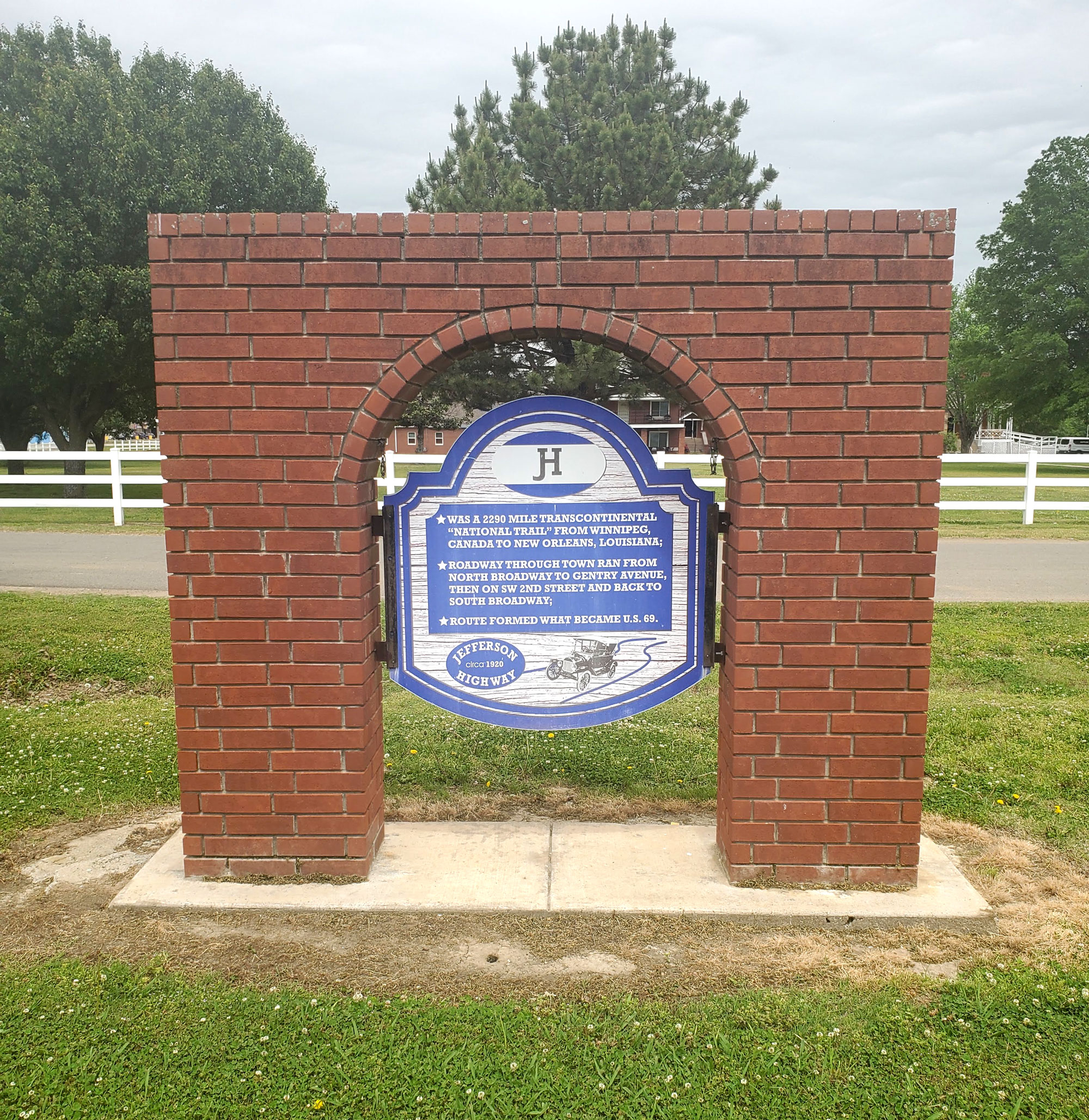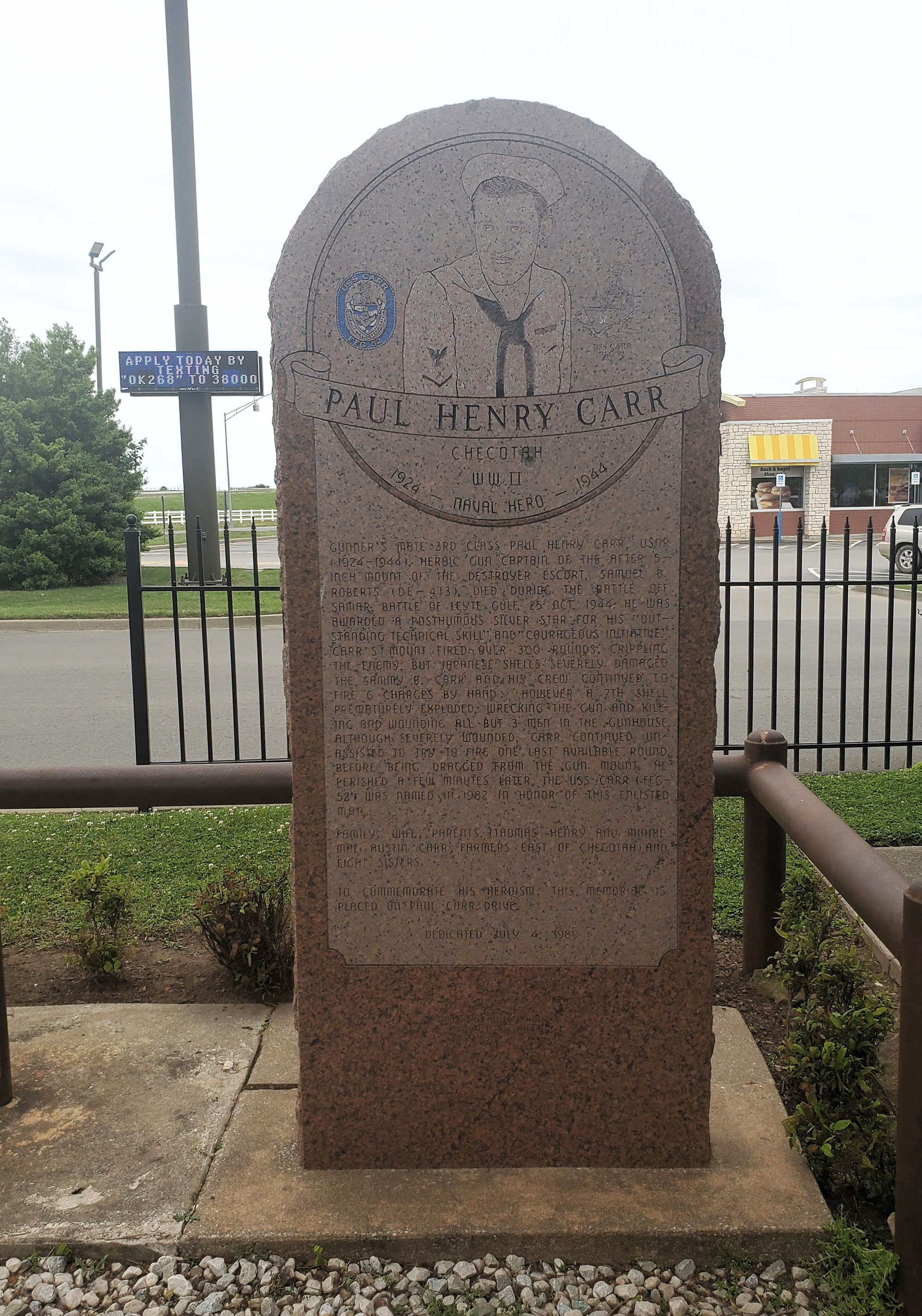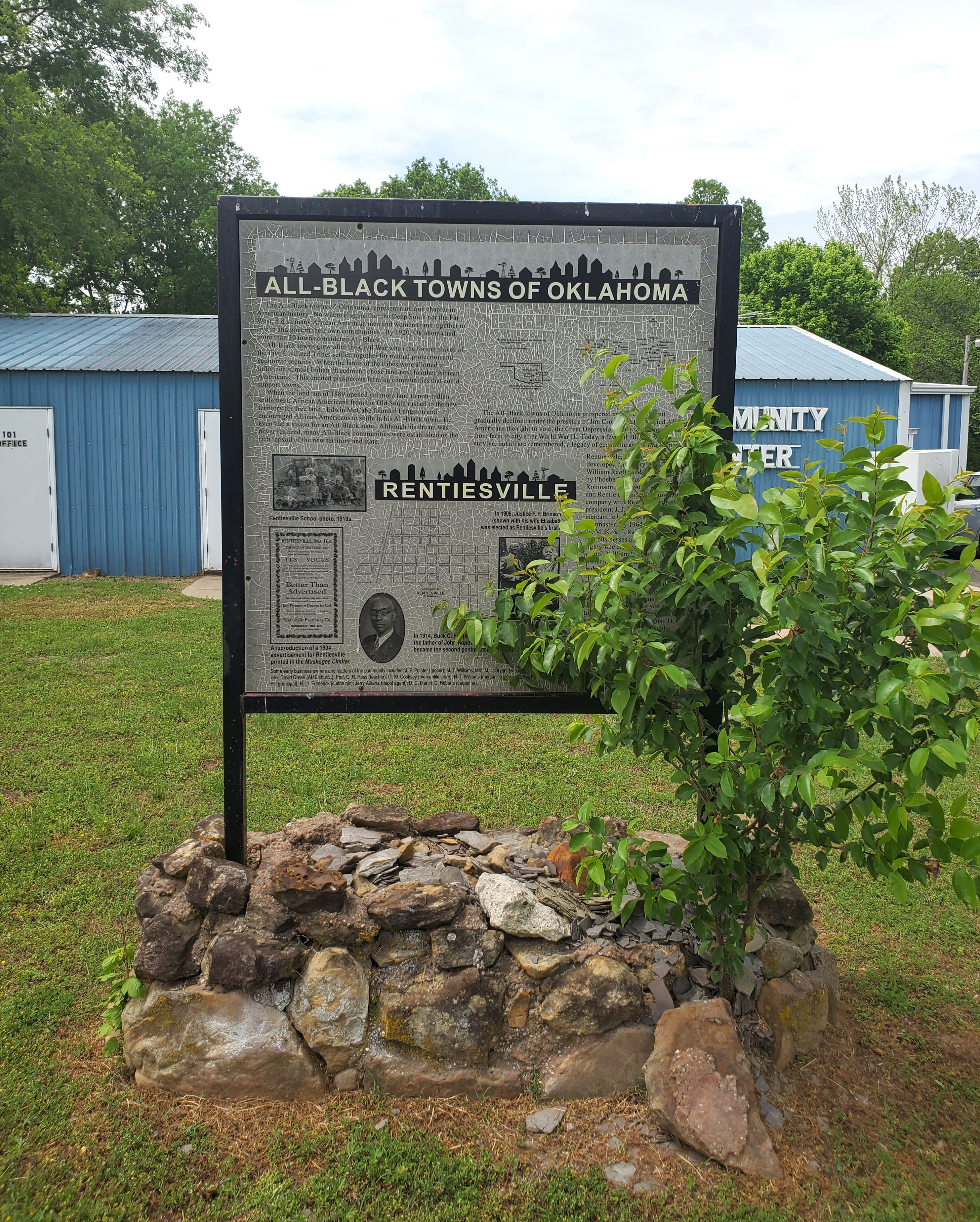
Historical Marker Program
Search Results
Your search returned 15 results.
Alexander Posey
McIntosh CountyLocation: off OK 9 in Posey Park, in Eufaula
Coordinates: 35.288483, -95.585067
Material: Aluminum
Sponsor(s): Oklahoma Historical Society and the Oklahoma Department of Transportation
Topics: American Indians; Arts; Government; Mass Communication; Territorial Period, 1861–1907
This famous Creek poet and journalist's life prematurely ended when he drowned in the North Canadian River near Eufaula on May 27, 1908. Alexander Posey was the editor of newspapers, a member of the Dawes Commission, and widely known for his poems such as "Ode to Sequoyah."
Note: This marker was originally located in Vivian (8 miles west of Eufaula) and moved to its present location at an unknown date. The marker text indicating the location of Posey’s birthplace in relation to the marker is now incorrect.

Asbury Manual Labor School
McIntosh CountyLocation: on BUS-69 in Greenwood Cemetery north of Eufaula
Coordinates: 35.293967, -95.582650
Material: Stone with bronze plaque
Sponsor(s): Oklahoma Methodist Historical Society
Topics: American Indians; Education; Religion/Philosophy
Stones that make up the monument are from the original buildings of Asbury Manual Labor School (est. 1847). The original site of the school lies under Lake Eufaula. Monument dedicated to Methodist missionaries who established the school for Native children and youth.
Buckner Cemetery
McIntosh CountyLocation: on BUS-69 in Greenwood Cemetery north of Eufaula
Coordinates: 35.293933, -95.582783
Material: Aluminum
Sponsor(s): Oklahoma Baptist Historical Commission
Topics: Family/Household; Religion/Philosophy; Westward Expansion, 1803–1861
Dr. Henry F. Buckner, called the "apostle to the Creeks," and members of his family are buried here, having been moved from the Buckner home now under Lake Eufaula. Buckner came to the Creeks as a Baptist missionary in 1849.
Creek Council Ground
McIntosh CountyLocation: at Eufaula Indian community at Seventh and Forest in Eufaula
Sponsor(s): Oklahoma Historical Society
Topics: American Indians; Government; Military; Recreational/Service; Social/Cultural
Confederate Commissioner Albert Pike met with Creek leaders at North Fork Town, now covered by the waters of Lake Eufaula, on July 10, 1861, to sign a treaty in which the Creeks pledged their support to the South in the Civil War.
Deputy U.S. Marshal James Nakedhead
McIntosh CountyLocation: on OK-150 in Lake Eufaula State Park
Coordinates: 35.419127, -95.628342
Material: Granite
Sponsor(s): Oklahoma Historical Society
Topics: American Indians; Government; Recreational/Service; Territorial Period, 1861–1907
James Nakedhead was a deputy US marshal killed in the line of duty in Indian Territory on February 27, 1895. A Cherokee policeman, he was the first town marshal of Tahlequah in 1890.
Green Corn Dance
McIntosh CountyLocation: near S. 6th Street and Forest Avenue at Creek Nation Health Clinic in Eufaula
Coordinates: 35.282639, -95.591389
Material: Granite
Sponsor(s): Oklahoma Historical Society
Topics: American Indians; Religion/Philosophy; Social/Culture
To the Creeks, the Green Corn dance was a major annual religious celebration of the harvest season. Around a central fire, men, women, and children dressed in colorful costumes, danced, chanted, and sang. After the rites, green corn was served.
Henry Frieland Buckner
McIntosh CountyLocation: in Greenwood Cemetery north of Eufaula
Topics: Family/Household; Religion/Philosophy; Westward Expansion, 1803–1861
Commemorates the work of Dr. Henry F. Buckner
Honey Springs Battlefield
McIntosh CountyLocation: on grounds of Honey Springs Battlefield Historic Site, Checotah vicinity
Coordinates: 35.530309, -95.486041
Material: Granite
Topics: American Indians; Ethnic Diversity; Government; Military; Territorial Period, 1861–1907
Five granite markers commemorate those who fought in the Civil War Battle of Honey Springs on July 17, 1863. Included are markers dedicated to Union soldiers, the Five Tribes, the First Regiment of Kansas Colored Volunteers, Confederate soldiers, and Texas Confederate soldiers. Marker sponsors include the Oklahoma Historical Society, the Intertribal Council of the Five Civilized Tribes, the Community Heritage Recognition Community, and Daughters of the Confederacy.
Jefferson Highway
McIntosh CountyLocation: at intersection of N. Broadway St. (BUS-69) and W. North Ave. in Checotah
Coordinates: 35.478463, -95.521519
Material: Other (Interpretive panel set in brick arch)
Sponsor(s): Checotah Landmark Preservation Society
Topics: Early Statehood, 1907–1941; Transportation
The Jefferson Highway (circa 1920) was a 2,290-mile transcontinental roadway from Winnipeg, Canada, to New Orleans, Louisiana. The highway through Checotah ran North Broadway to Gentry Avenue, then on Southwest 2nd Street and back to South Broadway. The route formed what became US Highway 69.

North Fork Town
McIntosh CountyLocation: at the intersection of Elm and Main Streets in Eufaula
Coordinates: 35.290390, -95.582318
Material: Aluminum
Sponsor(s): City of Eufaula and the Oklahoma Historical Society
Topics: American Indians; Military; Westward Expansion, 1803–1861
Important center of Texas Road in Creek Nation, from 1836. Post office established at Micco, 1853. Albert Pike secured treaties for Confederate States, signed here, 1861, by Choctaw, Chickasaw, and Creek Nations., Asbury School approved by Creek Council and supervised by Methodist Board established near here, 1848.
Note: This marker is missing.

Paul Henry Carr
McIntosh CountyLocation: on grounds of Katy Depot Museum and Visitor Center in Checotah
Coordinates: 35.471295, -95.536944
Material: Granite
Topics: Industrial Period, 1941 to, 1982; Military
Paul Henry Carr died during World War II in the Battle of Leyte Gulf, October 25, 1944. He was awarded a posthumous Silver Star for his "outstanding technical skill" and "courageous initiative" on the USS Samuel B. Roberts during the battle.

Rentiesville
McIntosh CountyLocation: in community of Rentiesville
Coordinates: 35.522796, -95.496731
Material: Other (Interpretive panel)
Sponsor(s): Oklahoma Historical Society
Topics: Early Statehood Early Statehood, 1907–1941; Ethnic Diversity; Settlement Patterns; Territorial Period, 1861–1907; Urban Development
Rentiesville is one of 13 All-Black towns, out of more than 50 that once existed, remaining in Oklahoma. While Tullahassee is reportedly the oldest, most were established between 1889 and 1907 as African Americans sought security and control of their own destiny in a segregated world. Rentiesville was founded in 1903 and a post office opened in 1904. The town soon boasted a lumber store, cotton gin, and several businesses. It is the birthplace of historian John Hope Franklin and hosts the Dusk ’til Dawn Blues Festival each year.

Tuskegee Baptist Church
McIntosh CountyLocation: at intersection of OK-9 and NS-411 (OBHC)
Coordinates: 35.289504, -95.698383
Material: Aluminum
Sponsor(s): Oklahoma Baptist Historical Commission
Topics: Folklife; Religion/Philosophy; Social/Cultural; Territorial Period, 1861–1907
Annie Walker Armstrong was corresponding secretary of the Woman's Missionary Union of the Southern Baptist Convention which sent missionaries to the area. The church was founded here in 1867. Nearby is another marker that notes the rock that Armstrong used to mount her horse during a visit to the church in 1900.
Vernon
McIntosh CountyLocation: in community of Vernon
Coordinates: 35.216608, -95.926825
Material: Other (Interpretive panel)
Sponsor(s): Oklahoma Historical Society
Topics: Early Statehood, 1907–1941; Ethnic Diversity; Religion/Philosophy; Urban Development
Vernon is one of 13 All-Black towns, out of more than 50 that once existed, remaining in Oklahoma. While Tullahassee is reportedly the oldest, most were established between 1889 and 1907 as African Americans sought security and control of their own destiny in a segregated world. Vernon, established in March 1912, is named for William T. Vernon, a minister and bishop in the African Methodist Episcopal Church, who also served as registrar of the United States Treasury from 1906 to 1912 under Presidents Theodore Roosevelt and William Taft.
Walker and Newton
McIntosh CountyLocation: in Lake Eufaula State Park
Topics: Government; Industrial Period, 1841–1892; Recreational/Service; Social/Cultural
A tribute to Oklahoma Highway Patrol trooper Bill Walker and Fountainhead State Park superintendent Leo Newton who were gunned down in a shoot-out in 1971.
(Page 1 of 1)
Marker Search
Browse by County
Alfalfa County
Atoka County
Beaver County
Beckham County
Blaine County
Bryan County
Caddo County
Canadian County
Carter County
Cherokee County
Choctaw County
Cimarron County
Cleveland County
Comanche County
Cotton County
Craig County
Creek County
Custer County
Delaware County
Dewey County
Ellis County
Garfield County
Garvin County
Grady County
Grant County
Greer County
Harmon County
Harper County
Haskell County
Hughes County
Jackson County
Jefferson County
Johnston County
Kay County
Kingfisher County
Kiowa County
Latimer County
Le Flore County
Lincoln County
Logan County
Love County
Major County
Marshall County
Mayes County
McClain County
McCurtain County
McIntosh County
Murray County
Muskogee County
Noble County
Okfuskee County
Oklahoma County
Okmulgee County
Osage County
Ottawa County
Pawnee County
Payne County
Pittsburg County
Pontotoc County
Pottawatomie County
Pushmataha County
Roger Mills County
Rogers County
Seminole County
Sequoyah County
Stephens County
Texas County
Tillman County
Tulsa County
Wagoner County
Washington County
Washita County
Woods County
Woodward County
To find out more about the Oklahoma Historical Society Historical Marker Program or how to submit an application, please visit the Historical Marker Program page.
Missing or Damaged Markers
Please use our online form to report missing or damaged historical markers.
Report Missing or Damaged Markers
Contact Us
If you have questions, please contact:
Matthew Pearce
Oklahoma Historical Society
800 Nazih Zuhdi Drive
Oklahoma City, OK 73105
405-522-8659
matthew.pearce@history.ok.gov





